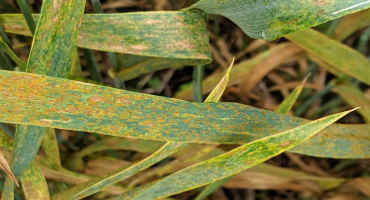By Emmanuel Byamukama, Shaukat Ali, and Connie Strunk
Winter wheat is past the need for an in-season fungicide application to manage fungal diseases, however, many spring wheat fields are yet to flower, making them prone to disease development. A few diseases, including leaf rust, stripe rust, and Fusarium head blight, have developed in winter wheat. This implies that there is enough inoculum available for these diseases to develop in spring wheat; especially East River, where rainfall has been frequent.
Diseases to Watch For
LEAF RUST
Leaf rust develops under warm temperatures (65-77° F) and humid conditions. This disease has reached yield reducing levels in some winter wheat fields (Figure 1). It has potential to develop in spring wheat, especially in fields that are at or have not reached the flag leaf growth stage. Stripe rust may not be a huge concern in spring wheat because this rust develops under cooler temperatures (<65° F). However cooler nights might cause stripe rust to develop at low severity levels.

Figure 1. Severe leaf rust developing in winter wheat near Brookings. Picture taken July 2, 2019
FUSARIUM HEAD BLIGHT
Fusarium head blight (FHB) or scab develops after flowering and can lead to bleaching of the entire wheat head or individual spikelets. Infected heads have shriveled chalky white seeds which have low test weight. FHB infection can also lead to an accumulation of mycotoxins; mainly, deoxynivalenol (DON). Grain with more than 2ppm DON can be docked or rejected at the elevator.
Management Strategy
To manage leaf diseases in spring wheat, scout at flag leaf to determine the need for a fungicide at this growth stage. If fungal leaf diseases can be observed on the leaf below flag leaf, a fungicide may be recommended to protect the flag leaf from disease development. Otherwise scouting should be done again at the flowering stage (50% plants flowering) for leaf diseases and also to assess the risk for scab development.
FHB risk assessment can be aided by FHB prediction tools which can be accessed at the SDSU Mesonet website and at FHB Prediction Center website. The SDSU-hosted FHB tool gives a table output when a nearby weather station is selected. This tool also gives likelihood for tan spot, leaf blotch and leaf rust to develop. The second link gives a map output and zooming in can show up to county level FHB risk. Spring wheat fields located in moderate to high risk of FHB should be treated with a fungicide. Fungicides applied to control FHB are also effective against fungal leaf diseases. The Wheat Pathology Working Group recommends Prosaro, Caramba, Miravis Ace and Proline as the most effective fungicides against FHB. Strobilurin (QoIs, FRAC code 11) fungicides should not be applied to wheat after heading because these have been found to increase DON in grain.
Source: sdstate.edu